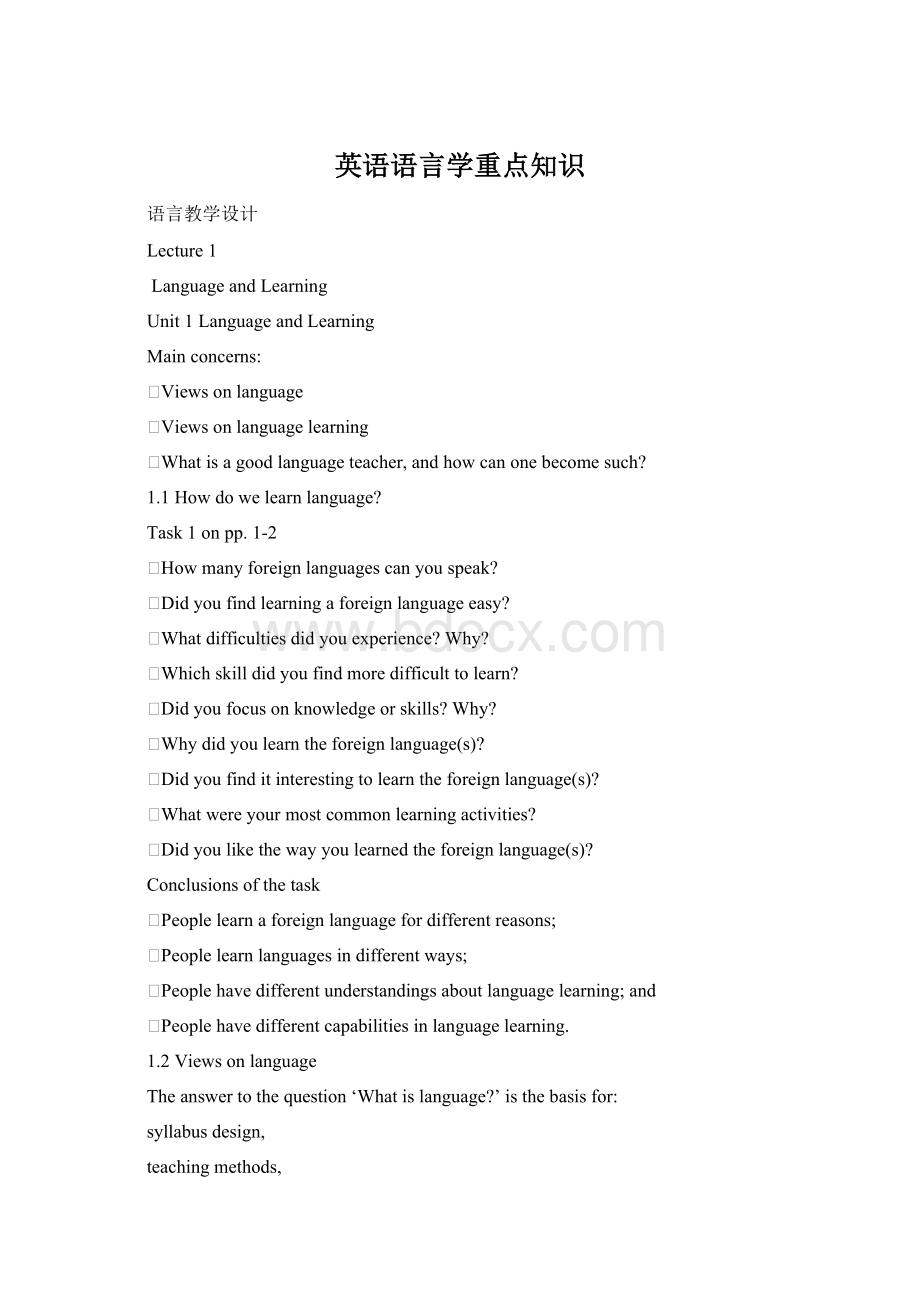英语语言学重点知识Word文档格式.docx
《英语语言学重点知识Word文档格式.docx》由会员分享,可在线阅读,更多相关《英语语言学重点知识Word文档格式.docx(47页珍藏版)》请在冰豆网上搜索。

⏹Peoplelearnlanguagesindifferentways;
⏹Peoplehavedifferentunderstandingsaboutlanguagelearning;
and
⏹Peoplehavedifferentcapabilitiesinlanguagelearning.
1.2Viewsonlanguage
Theanswertothequestion‘Whatislanguage?
’isthebasisfor:
syllabusdesign,
teachingmethods,
teachingprocedures,andteachingtechniques.
Adefinitionoflanguageisalways,
implicitlyorexplicitly,adefinitionof
humanbeingsintheworld.RaymondWilliams
Languageisapurelyhumanand
non-instinctivemethodofcommunicating
ideas,emotionanddesiresbymeansof
voluntarilyproducedsymbols.EdwardSapir
⏹Aset(finiteorinfinite)ofsentences,
eachfiniteinlengthandconstructedoutof
afinitesetofelements.NoamChomsky
Theinstitutionwherebyhumans
communicateandinteractwitheachother
bymeansofhabituallyused
oral-auditoryarbitrarysymbols.R.A.Hall
⏹DavidCrystal:
Thesystematic,conventionaluseof
sounds,signs,orwrittensymbols
inahumansociety
forcommunicationandself-expression.
Task2(p.2)
Whatislanguage?
Sampledefinitionsof“language”(p.177)
Language:
⏹isasystem/setofsymbols;
⏹is(primarily)vocal;
⏹isarbitraryandconventional;
⏹consistsofasetofrules(andisrule-governed);
⏹isrelatedtoculture;
⏹isusedforhumancommunicationorinteraction.
Itcanbedefinedinthreeways:
⏹itisafinitesystemofsoundunitswhicharecombinedaccordingtoacertainorder(asyntax)inordertoformaninfiniteamountofinformation;
itisanarbitrarysystemofsymbols;
awordisarbitrarilylinkedtoanobject;
itisasystemthatletsusexpresscurrenteventsaswellasrealandimaginaryonesbetheyinthepast,presentorfuture
Threedifferentviews
oflanguage
⏹Thestructuralview,
⏹Thefunctionalview,
⏹Theinteractionalview
Thestructuralview
Thestructuralviewseeslanguageasalinguisticsystem.
Thesystemoflanguage=thesystemofsounds+thesystemofwords+thesystemofgrammar
System
of
Language
3sub-systems
Thestructuralview
Thefunctionalview
(Thefunctional-notionalview)
Thefunctionalviewseeslanguageas
alinguisticsystem
andas
ameansfordoingthings.
Functionsoflanguage
e.g.
⏹offering,
⏹suggestion,
⏹advising,
⏹apologizing,
⏹etc.
Toperformfunctions,rulesandvocabularyareneededtoexpressnotions.
Notions
⏹presenttime,pasttime,andfuturetime;
⏹certaintyandpossibility;
⏹agentandinstrument;
⏹relationshipbetweenpeopleandobjects
Theinteractionalview
Theinteractionalviewseeslanguageas
acommunicativetool
(tobuildupandmaintainrelationsbetweenpeople).
Twothingsareneededforcommunication:
⏹Rulesoflanguageform(grammar&
vocabulary)
⏹Rulesoflanguageuseinacontext(Isitappropriatetousethislanguageiteminthiscontext?
)
Viewsonthenatureoflanguagehaveanimpactontheteaching/learningmethodofaperson.
1.3Viewsonlanguagelearning
Viewsonlanguagelearninginvolvetwoquestions:
⏹Whatarethepsycholinguisticandcognitiveprocessesoflanguagelearning?
⏹Whataretheconditionsforthelearningprocessestobeactivated?
⏹TheProcess-orientedtheoriesand
⏹TheCondition-orientedtheories
TheProcess-orientedtheories
TheProcess-orientedtheoriesconcernhowthemindprocessesnewinformation.
e.g.
⏹habitformation,
⏹induction,
⏹makinginference,
⏹hypothesistesting,
⏹generalization
TheCondition-orientedtheories
TheCondition-orientedtheoriesconcernthenatureofthehumanandphysicalcontextinwhichlanguagelearningtakesplace.
⏹numberofstudents,
⏹whatkindofinputlearnersreceive,
⏹learningatmosphere
TheBehaviouristtheory
and
TheCognitivetheory
TheBehaviouristtheory
⏹WatsonanRaynor:
astimulus-responsetheoryofpsychology
Accordingtothetheory:
Formsofbebavioursuchasmotions,habits,etc.areseenaselementsthatcanbeobservedandmeasured.
⏹“Youcantrainananimaltodoanything(withinreason)ifyoufollowacertainprocedurewhichhasthreemajorstages,stimulus,response,andreinforcement.”
(Harmer.1983:
30)
⏹Skinner:
Languageisalsoaformofbehaviour.
⏹USA:
TheAudio-LingualMethod(the“listen-and-repeat”drillingactivities).Mistakeswereimmediatelycorrected.
TheCognitivetheory
Chomsky’squestion:
Ifalllanguageisalearnedbehaviour,howcanachildproduceasentencethathasneverbeensaidbyothersbefore?
五岁女孩:
“中国队加油!
外国队漏油!
”(2005.05.05晚上9:
30)
TheimpactofChomsky’stheoryonlanguageteaching
Ø
Oneinfluentialideaisthatstudentsshouldbeallowedtocreatetheirownsentencesbasedontheirunderstandingofcertainrules.
ThisideaisclearlyinoppositiontotheAudio-LingualMethod.
1.4Whatis
agoodlanguageteacher?
kind,dynamic,authoritative,speakingclearly,creative,patient,well-informed,hardworking,resourceful(havingtheabilitytofindawayroundthedifficulty),attentive,warm-heartedwell-prepared,flexible,intuitive,accurate,enthusiastic,humourous,caring,disciplined,professionally-trained(Parrot.1993)
1.5Howcanonebecomeagoodlanguageteacher?
Teaching:
isitacraft,orisitanappliedscience?
⏹Ifwetaketeachingasacraft,thenwewouldbelievethatanoviceteachercanlearntheprofessionbyimitatingtheexperts’techniques,justlikeanapprentice.
⏹Ifwetaketeachingasanappliedscience,thenwewouldbelievethatknowledgeandexperimentationarenecessary.
AcompromisebetweenthetwoviewsbyWallace(1991)
⏹Stage1:
Languagetraining
⏹Stage2:
3sub-stages:
1)learning;
2)practice;
3)reflection
⏹Stage3:
Goal(professionalcompetence)
⏹WhatdoesthedoublearrowbetweenStage1andStage2mean?
⏹Inwhichstagedoesthiscoursetakeplace?
⏹WhyarePracticeandReflectionconnectedbyacircle?
SummaryofUnit1
⏹Thestructuralview,thefunctionalview,andtheinteractionalview
⏹TheProcess-orientedtheoriesandtheCondition-orientedtheories
⏹TheBehaviouristtheoryandtheCognitivetheory
⏹Qualitiesofagoodlanguageteacher
⏹Ethicdevotion,professionalquality,andpersonalstyle
⏹Thethreestagesofbecomingagoodlanguageteacher
EndofUnit1
Thankyou!
Communicative
PrinciplesandActivities
CommunicativeLanguageTeaching(CLT)
Frameworkofthislecture:
Languageuseinreallifev.s.traditionalpedagogy;
Communicativecompetence;
Theimplementationoflanguageskills;
Communicativeactivities.
2.1Languageuseinreallife
vs.
traditionalpedagogy
⏹Theultimategoalofforeignlanguageteachingis:
toenablethelearnerstousetheforeignlanguageinworkorlife
⏹Therefore,weshouldteach:
thatpartofthelanguagethatwillbeused;
inthewaythatisusedintherealworld.
Gapsbetweentheuseoflanguageinreallifeandthetraditionalforeignlanguageteachingpedagogy:
(pp.14-15)
⏹Inreallife:
?
⏹Thetraditionalpedagogy:
⏹Theconsequence:
⏹Task1.
Languageisusedtoperformcertaincommunicativefunctions.
focusesonformsratherthanonfunctions.
Thelearnershavelearnedalotofsentencesorpatterns,buttheyareunabletousethemappropriatelyinrealsocialsituations.
Weuseallskills,includingthereceptiveskillsandtheproductiveskills.
⏹Thetraditionalpedagogytendstofocusononeortwolanguageskillsandignoretheothers.
Thelearnerscannotusethelanguageinanintegratedway.
Languageisalwaysusedinacertaincontext.
⏹Thetraditionalpedagogytendstoisolatelanguagefromitscontext.e.g.thepassive
Thestudentsarepuzzledabouthowtousethelanguageinaparticularcontext.
2.2Fosteringcommunicativecompetence
ThegoalofCLTistodevelopstudents’
communicativecompetence.
CommunicativeCompetencevs.LinguisticCompetence
⏹LinguisticCompetence=
grammaticalknowledgeor
knowledgeaboutthelanguageform
⏹CommunicativeCompetence=
Knowledge&
abilityfor:
rulesofform/grammar+rulesofuse
Languagecompetenceandcommunicativecompetence
a.Chomsky’stheory:
competencesimplymeansknowledgeofthelanguagesystem:
grammaticalknowledgeinotherwords
b.Hymes’stheory:
“thereare“rulesofusewithoutwhichtherulesofgrammarwouldbeuseless”.Besidesgrammaticalrules,languageuseisgovernedbyrulesofuse,whichensurethatthedesiredorintendedfunctionsareperformedandthelanguageusedisappropriatetothecontext.
AccordingtoHymes(1979),communicativecompetenceincludesfouraspects:
(pp.15-16)
⏹knowingwhetherornotsomethingisformallypossible(grammaticality:
grammaticallyacceptable);
知道形式上是否可能
⏹know